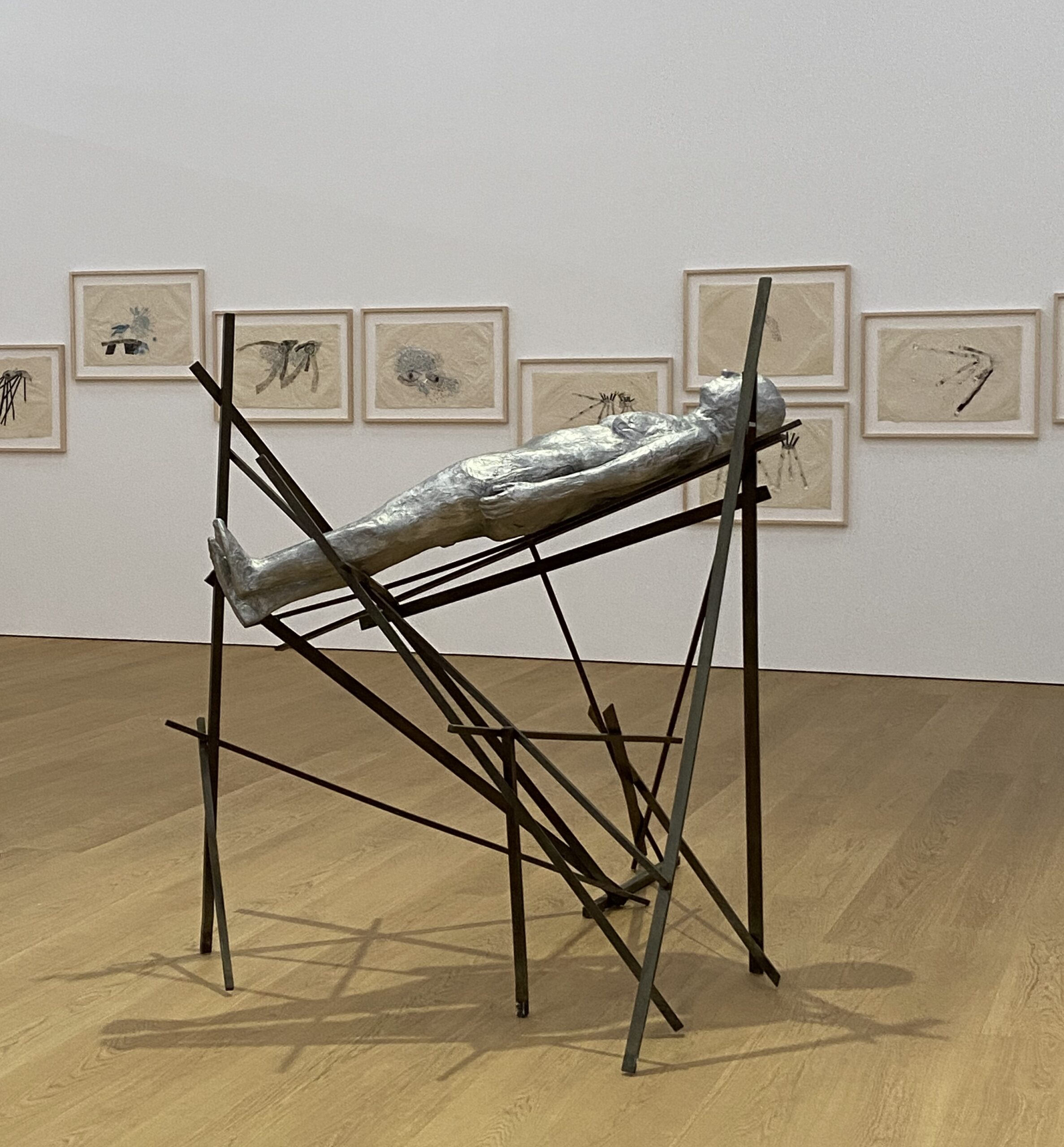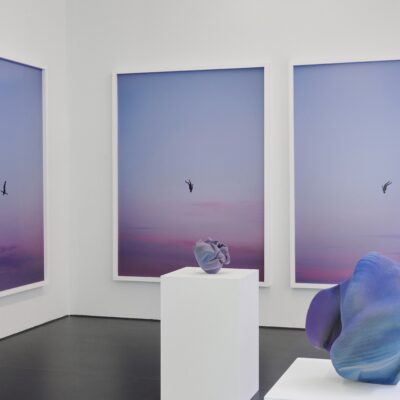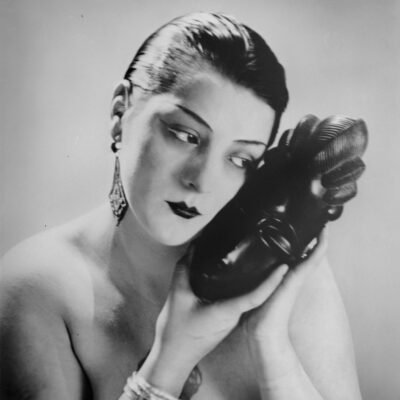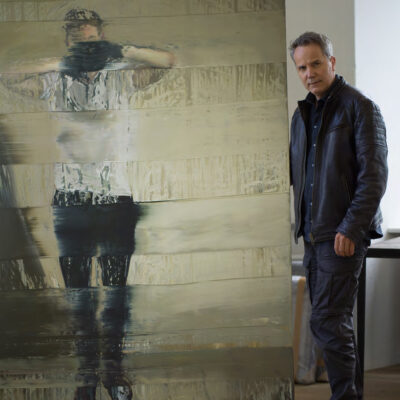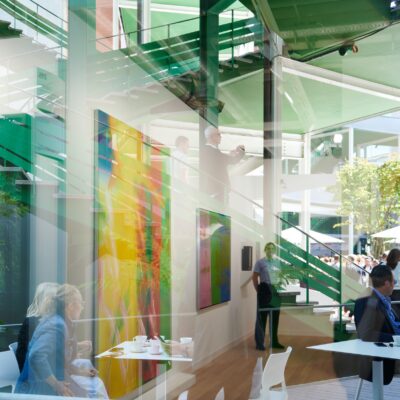The Kiki Smith (b 1954) exhibition “Hearing You with My Eyes” at the Musée Cantonal des Beaux Arts (MCBA) focuses on the senses, in particular, sight, hearing and touch. The materials on display show Smith’s full range of work, from a roomful of massive tapestries to papier-mâché sculptures, videos, works on paper, bronze sculptures and photographs. Two floors of the museum display almost 100 pieces. In describing the show in an MCBA video, Smith says: “it is about synesthesia, where you have an interconnection between different senses, and how our perception of things is much broader than we think they are and much more holistic and inclusive.”
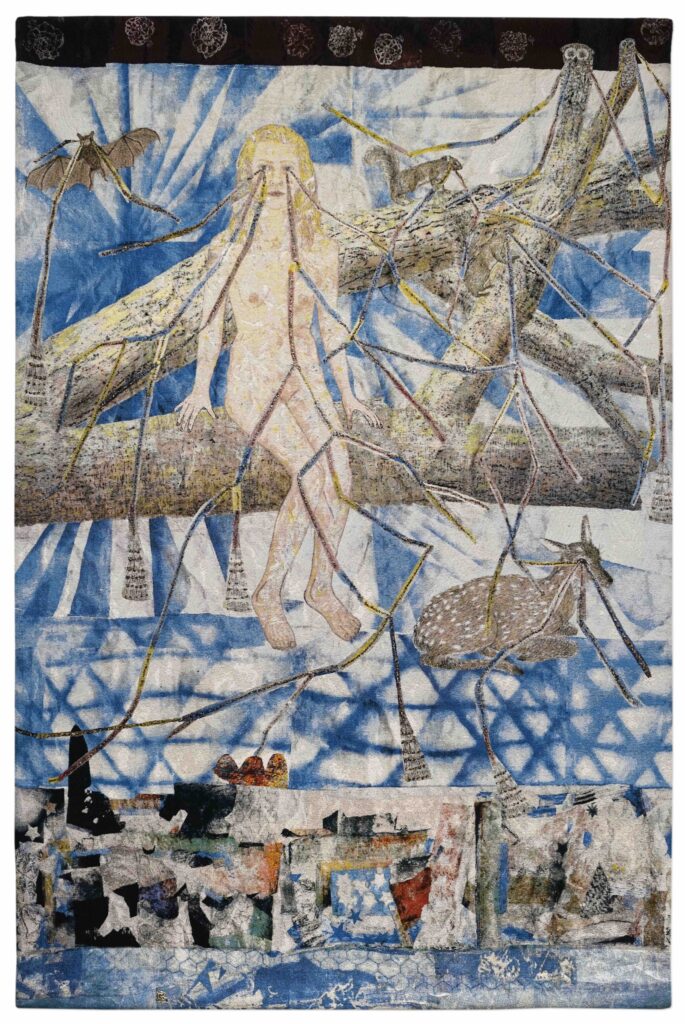
This interconnection between the senses can be seen in many of the pieces, notably, in the twelve tapestries spanning the walls in one gallery, dating from 2012 to 2015. Woven with shimmering threads and shades from the natural world, these were inspired by a visit Smith made to the Chateau d’Angers when she was 30 years old to see the Apocalypse Tapestry, which made a huge impact. Smith’s tapestries were made at the Magnolia Editions in California using the jacquard weaving process. Smith initially drew the pieces in a 1:1 scale in layered collages. They were then digitally photographed and worked by hand and eventually woven into the tapestry.
The themes of the tapestries draw from the four elements; fire, water, earth and air, as well as the artist’s time spent in the countryside, close to nature. Wolves, stars, the moon, women, birds, and plants populate the woven surfaces, intertwined together, exemplifying the concept of synesthesia. In “Congregation”, crisscrossed lines flow out of the eyes of the bat, squirrel, deer and woman, linking the creatures together in the web of life.
Smith has been a prolific artist for over forty years. Born in Germany, Kiki Smith and family moved to New Jersey a year later in 1955. She grew up in the suburbs, riding her bicycle and enjoying the freedom to explore her surroundings. She attended Hartford Art School in Connecticut and then moved to New York City in 1976, joining an art collective called Collaborative Projects or “Colab”. Prompted by her father’s and sister’s deaths in the 1980’s, Smith began an ambitious investigation of mortality and the physicality of the human body. She also trained as an Emergency Medical Technician, deepening her knowledge of anatomy. For many years, the human body, its functions, fluids, and depictions, has been central to her work as well as a deep interest in nature and our relationship to it.
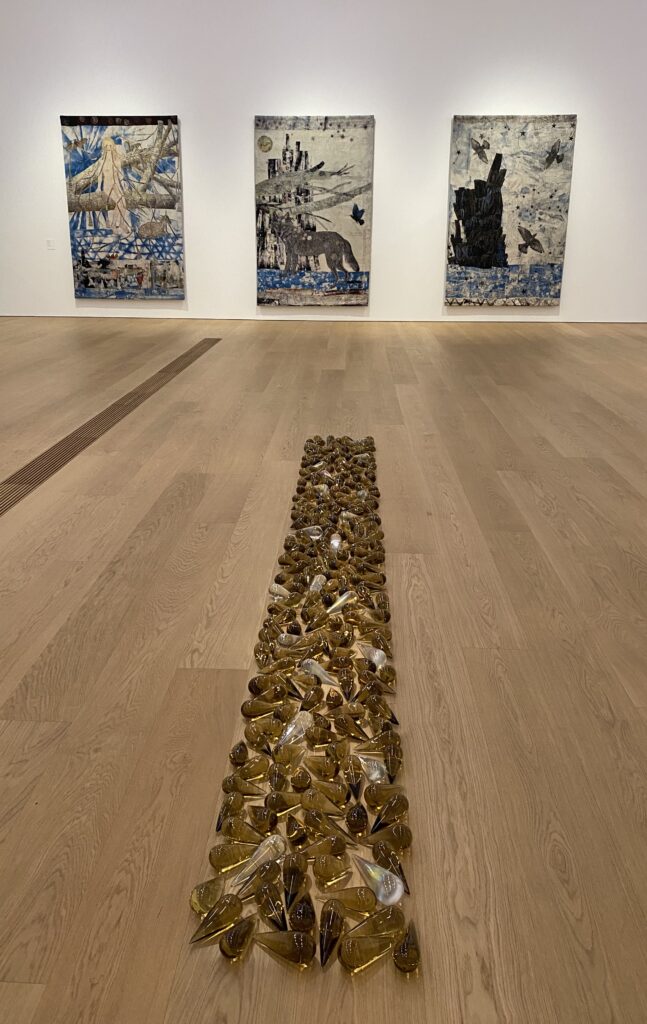
The 247-piece tear-shaped “Brown Water” (1999) provides balance to the majesty of the tapestries. They pull us back to earth, and the corporal world. Smith has, throughout her artistic career, depicted the bodily fluids and secretions which flow out of us all, regardless of who we are. By using glass, which for Smith “is a metaphor of water and the sky”, she turns a brown-coloured liquid akin to human waste into something beautiful. Mixed in with the brown tears are clear ones, illustrating the variety of the human experience by way of these glass drops.
Embodying this sensibility, as well as Smith’s focus on the human body, is the sculpture “Untitled”, 1992. Almost life-size, the figure is nearly featureless, enabling us to relate to it as a human being, regardless of gender. This blankness also draws our attention to the open cut in the chest cavity where colourful ribbons spill out onto the floor, symbolising the internal organs. Turning the inside out, and revealing parts of the body that are normally hidden, are themes that run through Smith’s work. As such, she exposes people for what they are at the most basic level, an envelope containing parts that allow us to function.

Continuing with the theme of the human experience, “My Blue Lake”, 1995, is a photograph taken with a 360-degree camera that belonged to the British Museum in London. This photograph provides a total view of Smith’s face and upper torso, as if the skin were cut off and flattened out or unfolded. Leaving no part or crevice unexplored, there is nothing hidden in this depiction. In a sense, it removes recognisable details of the person, as body parts are shifted into new locations, and the image becomes less human. Furthermore, the colouring and title of the photograph remind one that 60% of the human body is made of water, transforming the image into a topographical map, with the red hair anchoring it to the earth. It is a grounding image, reminding us of humanity with all of its imperfections.
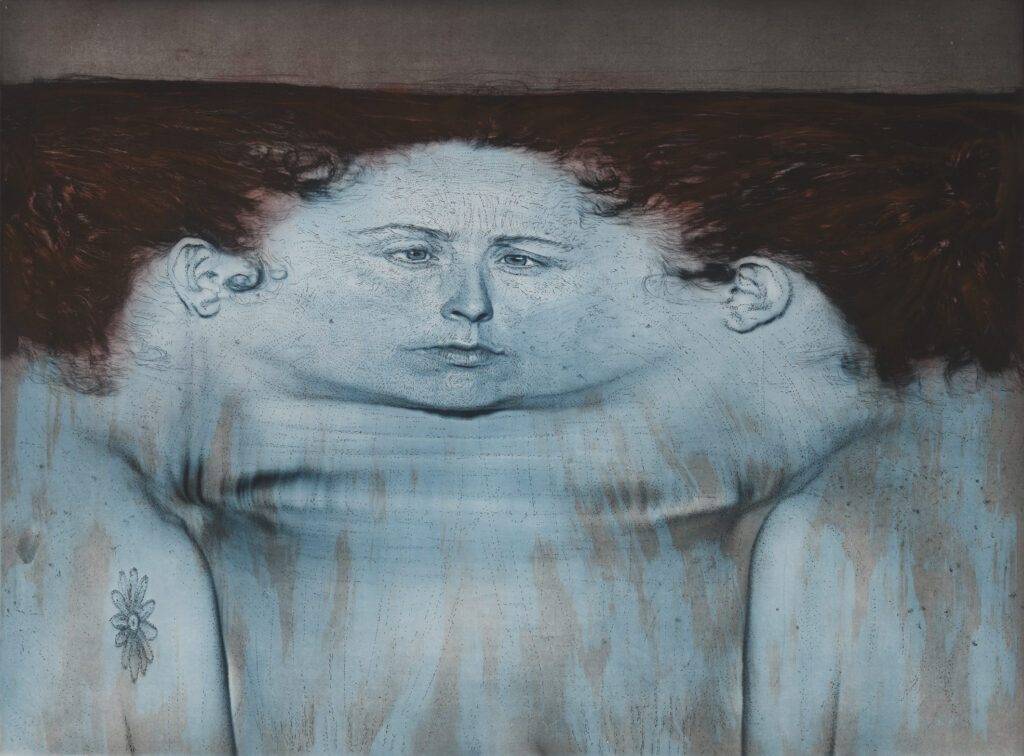
Another captivating room contains the sculpture, “Rapture”, 2001, along with “Rogue Stars”, 2012. The glistening figure in “Rapture” was based on the body of Smith’s friend Genevieve Cadieux. The female figure is depicted stepping out of the body of a wolf lying supine on the floor, its gut cut open. Mythology and fairytales influenced Smith starting in the late 1990’s. Stories such as Little Red Riding Hood, who was eaten by a wolf posing as her grandmother and saved by a hunter cutting open the wolf’s body, are appropriated and re-written by Smith. In this version, a powerful and triumphant woman stands on the body of the wolf. She emerges from the carcass, unscathed by her interaction with the beast.

It also evokes the image of Botticelli’s “Birth of Venus”. However, whereas Venus is shown in a modest pose, covering her body with her hands and cloth, the figure in “Rapture” is fully nude, and in an open, strong stance. As Smith remarked: “Certainly part of what you do in art or in the space of art is demystify the world, which doesn’t make the world any less inexplicable or magical or less meaningful, but just that you have access to it and have more experience of it.” In fact, Smith made a sculpture titled “Daughter” of a girl with a wolf head and red cape, combining Little Red Riding Hood with the wolf, as well as drawings such as “Lying with the Wolf” in which a woman embraces the animal. “Rapture” can then also be interpreted as representing the symbiotic, interdependent relationship between humans and animals.
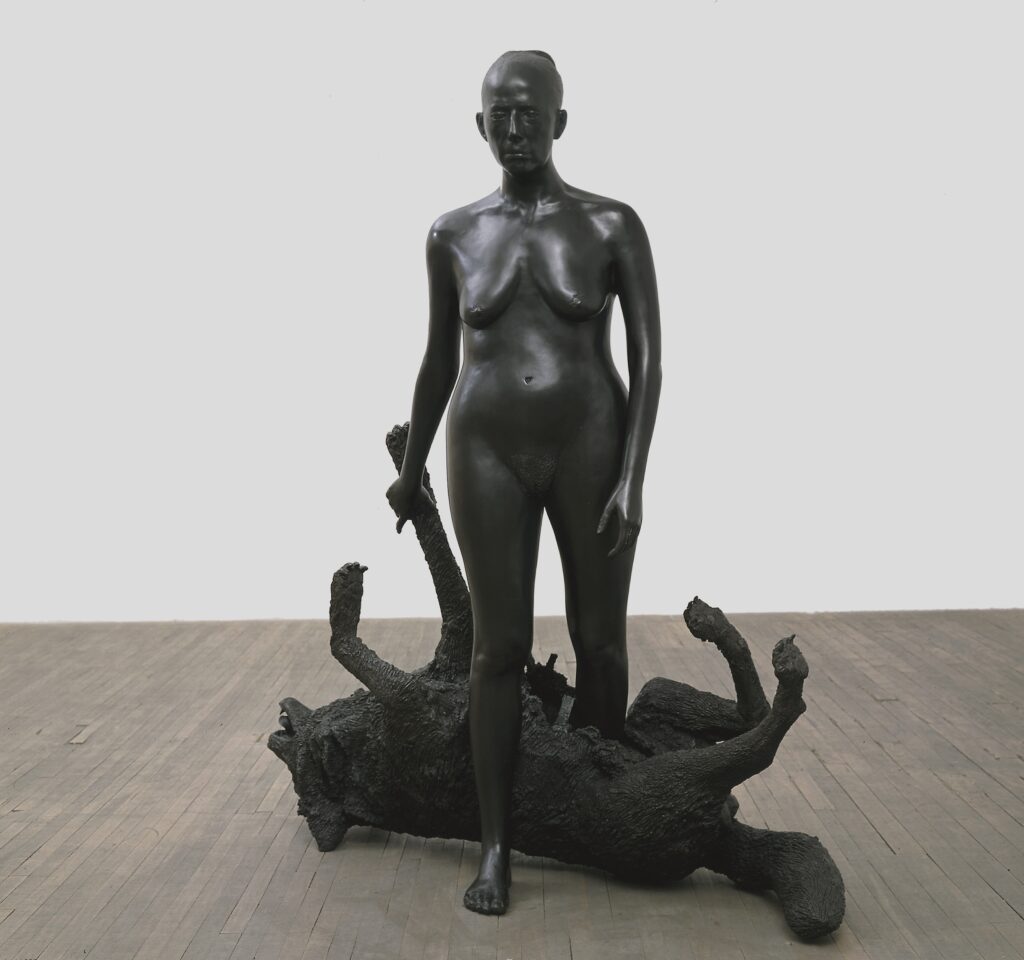
“Moon on Crutches”, 2002, represents aspects of feminist themes often found in Kiki Smith’s work. As Smith has affirmed, feminism is “a human rights issue that people in the last century and this century are trying to address.” The Moon, for Smith, represents femininity, and she has created many pieces showing the actual Moon on wooden structures, similar to those in this piece. In addition, “Woman on Pyre”, 2001, depicted a female figure kneeling on stacks of wood, referencing those women burned at the stake for being “witches”. In this piece, aluminum female figures are placed on pyre-like bronze constructions. The bodies are stiff and heavy-looking, resting precariously on seemingly unstable structures. They are nevertheless robust, able to withstand whatever is inflicted on them by outside forces.

This exhibition brings Kiki Smith back to Switzerland, where her first solo show in Europe was held in Geneva, in 1990, at the Centre d’Art Contemporain. Following that show, she joined Pace Gallery in 1994. An exhibition of her work, titled “Light”, is currently being shown at Pace Gallery in Geneva. The show has pieces ranging from aluminium, bronze, and wooden sculptures, to cyanotype prints and tapestries. The Pace Gallery display complements the MCBA show by extending the range of Smith’s pieces one can see in the French-speaking part of Switzerland.
In the exhibition view below, one sees the light bouncing off and reflected from the surfaces of “Spiral Nebula”, a work with a celestial theme. In the background, her cyanotypes capture rays of light on water. Made by etching marks onto plexiglas and layering them over light-sensitive paper, the result is dreamy, starry images. These pieces reflect the artist’s interest in nature and our connection with it. Smith stated: “We are part of the natural world and our identity is completely attached to our relationship to our habitat and animals.” Her work encourages us to contemplate where our place, as humans, is in the world. “Light” at Pace Gallery illustrates the multifaceted approach to creating that Smith has pursued throughout her career.
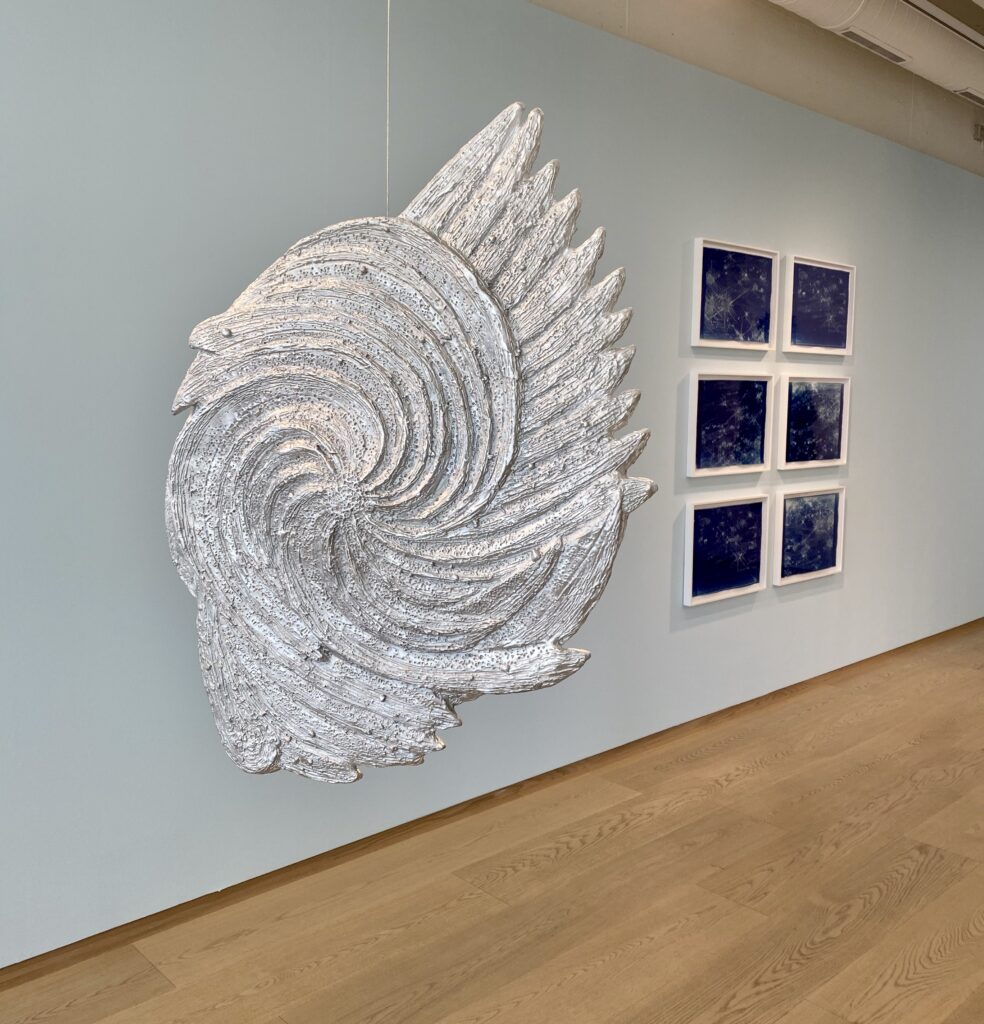
Both of these exhibitions allow us to understand the range and depth of Smith’s creativity. While some pieces, such as the works on paper, have a homemade quality to them, others are precisely executed in material such as bronze or woven jacquard, drawing from historic traditions. All of them add to the complex mixture that makes up Smith’s extensive body of work. From her focus on the human figure and feminist themes, to her more recent interest in the natural world and our place in it, these themes are fully explored in both shows. When asked about her upcoming projects in the MCBA video, Smith’s ambitions are humble. She says she wants to make sculptures of ferns, and other plants. This is clearly a reachable goal, and underlines how important the natural world is to Smith at this moment in time. As she says: “Nature is everything, culture comes and goes.”
Too view a video of Kiki Smith talking about her work and career from the Louisiana Channel click the link below. (Permission given by the Louisiana Museum of Modern Art).
